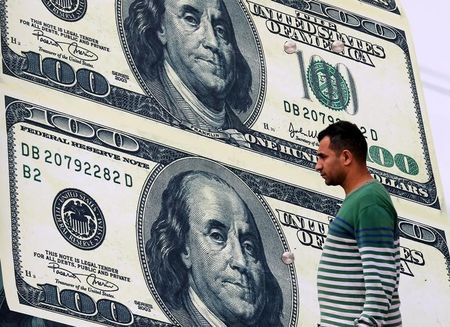Forex
Dollar stabilizes near recent highs; sterling gains on strong PMI data

Investing.com – The U.S. dollar stabilized near its recent over four-month high in European trade Tuesday as strong economic data hit expectations of early rate cuts by the Federal Reserve.
At 05:40 ET (10:40 GMT), the Dollar Index, which tracks the greenback against a basket of six other currencies, traded largely unchanged at 104.755, just below the previous session’s 105.07 top, its highest level since the middle of November last year.
Dollar boosted by reduced rate cut expectations
The greenback received a boost Monday after data showed the first expansion in U.S. manufacturing since September 2022.
Further signs of U.S. economic strength has resulted in traders reining in expectations of early interest rate cuts by the Federal Reserve, supporting the dollar.
The CME’s FedWatch tool now factors in 61.3% odds of a Fed rate cut in June, down from about 70.1% probability a week ago.
There is more economic data to digest Tuesday, including and , both for February, ahead of Friday’s widely-watched payrolls report for March.
“Looking ahead, this week features a myriad of Fed speakers. Given the direction of travel of the U.S. data recently, it seems hard to expect any renewed dovishness on their side,“ said analysts at ING, in a note.
“Markets expect a slightly lower JOLTS job opening figure today,” ING added, “we see this data as a potential market mover which, if soft, could reverse some of the dollar gains seen late last week.”
Sterling gains on strong manufacturing data
In Europe, fell 0.1% to 1.0738, dropping after eurozone manufacturing activity took a further turn for the worse in March, contracting at a steeper pace than in February.
HCOB’s final , compiled by S&P Global, dipped to 46.1 in March from February’s 46.5, beating a preliminary estimate of 45.7, but staying below the 50 mark denoting growth in activity for a 21st month.
“Two-year EUR:USD swap rate differentials are now at 145bp in favor of the dollar. These are the most supportive rate conditions for the dollar since December 2022,” ING said. “No wonder EUR/USD is comfortably trading under 1.0800. The 1.0695/1.0700 lows seen in mid-February are now an obvious short-term target.”
rose 0.2% to 1.2569, bouncing after recent losses after British manufacturers reported their first overall growth in activity in 20 months in March, suggesting last year’s shallow recession has ended.
The S&P Global/CIPS rose to 50.3, higher than a preliminary March reading of 49.9 and up from February’s 47.5. The last time this index was above the 50 threshold for growth was in July 2022.
Yen remains on intervention watch
traded 0.1% higher at 151.68, just below the 151.80 level seen earlier in the session, the weakest level since it reached a 34-year trough of 151.975 last week.
Finance Minister Shunichi Suzuki reiterated earlier Tuesday that he wouldn’t rule out any options to respond to disorderly currency moves.
Japanese authorities entered the currency market three times in 2022, selling the dollar to buy yen, first in September and again in October as the yen slid towards 152 to the dollar.
rose 0.1% to 7.2358, with the yuan falling to a 4-1/2-month low against the dollar, offsetting selling of the U.S. currency by state-owned banks.

 Forex3 years ago
Forex3 years agoForex Today: the dollar is gaining strength amid gloomy sentiment at the start of the Fed’s week

 Forex3 years ago
Forex3 years agoUnbiased review of Pocket Option broker

 Forex3 years ago
Forex3 years agoDollar to pound sterling exchange rate today: Pound plummeted to its lowest since 1985

 Forex3 years ago
Forex3 years agoHow is the Australian dollar doing today?

 Cryptocurrency3 years ago
Cryptocurrency3 years agoWhat happened in the crypto market – current events today

 World3 years ago
World3 years agoWhy are modern video games an art form?

 Commodities3 years ago
Commodities3 years agoCopper continues to fall in price on expectations of lower demand in China

 Economy3 years ago
Economy3 years agoCrude oil tankers double in price due to EU anti-Russian sanctions





















